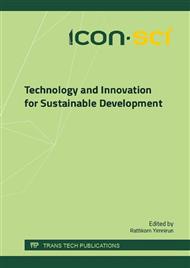[1]
E. Pinho, M. Henriques, R. Oliveira, et al. Development of Biofunctional Textiles by the Application of Resveratrol to Cotton, Bamboo, and Silk. Fibers Polym, 11(2008) 271.
DOI: 10.1007/s12221-010-0271-x
Google Scholar
[2]
Sokker H, Badawy S, Zayed E, Nour Eldien F, Farag A (2009) Radiation-induced grafting of glycidyl methacrylate onto cotton fabric waste and its modification for anchoring hazardous wastes from their solutions. J Hazard Mater 168: 137–144.
DOI: 10.1016/j.jhazmat.2009.02.039
Google Scholar
[3]
S. Shahidi, A. Rashidi, M. Ghoranneviss, A. Anvari, M. K. Rahimi, M. BameniMoghaddam,J. Wiener, Investigation of metal absorption and antibacterial activityon cotton fabric modified by low temperature plasma, Cellulose 17 (2010) 627–634.
DOI: 10.1007/s10570-010-9400-3
Google Scholar
[4]
S. Shahidi, Novel method for ultraviolet protection and flame retardancy of cotton fabrics by low-temperature plasma, Cellulose 21 (2014) 757–768.
DOI: 10.1007/s10570-013-0127-9
Google Scholar
[5]
A. Rashidi, S. Shahidi, M. Ghoranneviss, S. Dalalsharifi,J. Wiener, Effect of Plasma on the Zeta Potential of Cotton FabricsPlasma Science and Technology, 15, (2013) 455-458.
DOI: 10.1088/1009-0630/15/5/12
Google Scholar
[6]
Chan, Polymer Surface Modification and Characterization, Hanser Publisher, Munich Vienna New York, (1994).
Google Scholar
[7]
M. Sarmadi, F. Denes, 1996, Surface Modification of Polymers under Cold Plasma Conditions, Tappi Journal, Vol. 79, No, 8, p. pp.189-204.
Google Scholar
[8]
M. Carmen, A. Almazan, J. Paredes, M. Perez-Mendoza, M. Domingo-Garcia M, F. Lopez-Garzon, A. Martinez-Alonso, J. Tascon, Effects of oxygen and carbon dioxideplasmas on the surface of poly(ethylene terephthalate). JColloid InterfSci 287 (2005) 57.
Google Scholar
[9]
C. Nastase, F. Nastase, A. Dumitru, M. Ionescu, I. Stamatin, Thin film composites of nanocarbons-polyaniline obtainedby plasma polymerization technique. Compos PartAApplSciManuf 36 (2005) 481.
DOI: 10.1016/j.compositesa.2004.10.009
Google Scholar


